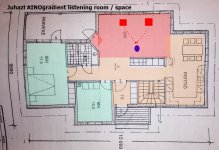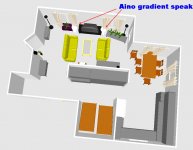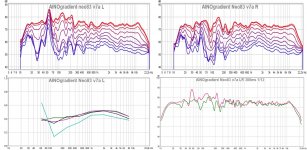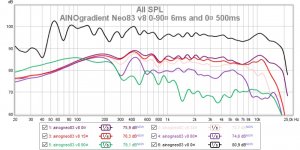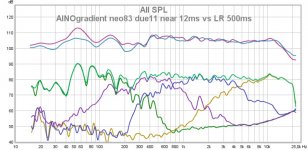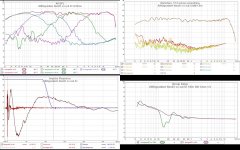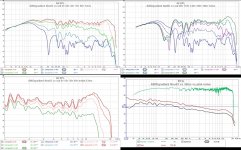Thats because we've been having record breaking temps and that translates to a very warm the gulf stream pumping heat into europe. This is caused by an El Nino in the Pacific, which helps us out by providing alot of sheer wind out of the west that prrvents the formation of Hurricanes.
"Hi Juha,
Constant directivity loudspeaker designs
Thank you and Happy Holidays to you.
Siegfried Linkwitz"
Constant directivity loudspeaker designs
Thank you and Happy Holidays to you.
Siegfried Linkwitz"
We had no snow at Christmas here, so Santa had to use a SLK!
https://www.youtube.com/watch?v=wly-6lJJzOU
Back to acoustics during holidays... My home and livingroom make a huge resonance chamber specially between 80-300Hz (low RT and EDT). This is generally a good feature, gives good resolution, but it also sort of sucks lots of bass energy. Take a look at pictures, notice also difference L/R.
It is nice to have a minidsp-controlled multiway loudspeaker system to attack these acoustic challenges. Room acoustic treatment is out of question and it is not even likely to make any fundamental improvements in this special case.
https://www.youtube.com/watch?v=wly-6lJJzOU
Back to acoustics during holidays... My home and livingroom make a huge resonance chamber specially between 80-300Hz (low RT and EDT). This is generally a good feature, gives good resolution, but it also sort of sucks lots of bass energy. Take a look at pictures, notice also difference L/R.
It is nice to have a minidsp-controlled multiway loudspeaker system to attack these acoustic challenges. Room acoustic treatment is out of question and it is not even likely to make any fundamental improvements in this special case.
Attachments
Last edited:
Your journey in this thread has been a great read.
With the 12MWNd now discontinued, what do you think would be an alternative (except the obvious 12P80Nd)?
Regards
With the 12MWNd now discontinued, what do you think would be an alternative (except the obvious 12P80Nd)?
Regards
Hi, thanks! I don't think that driver properties are critical here. I selected a heavily built high-efficiency pro-type driver, which also looks sexy! A Peerless SLS12 would be nice, so is Beyma 12P.
Juhazi,
I'm thinking about trying dipoles or cardioids in my car. The reason is because I find that the bass is 'tighter' and 'dryer' due to less interaction with the room, and it seems like this should work in a car too.
As I see it there are three options:
1) a dipole midbass running from about 125hz - 500hz
2) a resistive enclosure to make a cardioid from 125hz - 500hz
3) an active cardioid using two drivers and DSP to create a cardioid from 125hz - 500hz
Cost isn't a big concern, I just want good performance. What would you recommend?
To me it seems like dipole is the simplest, but due to the driver being in a car, the driver would only be 10cm away from a boundary. Due to that, perhaps a cardioid would be superior?
I'm thinking about trying dipoles or cardioids in my car. The reason is because I find that the bass is 'tighter' and 'dryer' due to less interaction with the room, and it seems like this should work in a car too.
As I see it there are three options:
1) a dipole midbass running from about 125hz - 500hz
2) a resistive enclosure to make a cardioid from 125hz - 500hz
3) an active cardioid using two drivers and DSP to create a cardioid from 125hz - 500hz
Cost isn't a big concern, I just want good performance. What would you recommend?
To me it seems like dipole is the simplest, but due to the driver being in a car, the driver would only be 10cm away from a boundary. Due to that, perhaps a cardioid would be superior?
Hi, dipole bass needs lots of room to work, and I mean a large living room or something like that like. In a car you would hardly get any reasonable dipole bass output say below 300Hz.
Cardiod bass construction is a large thing too, even with two drivers, again because of wavelength. In upper hundreds of Hz that could work, but again constructions get quite large. Please try it anyway! Perhaps resistive side vents is the best way to go.
Sorry to say, I don't see any way of making those work in a car. Perhaps in a school bus?
My AINOs have closed box downfire subwoofers, because I can't place them far enough from front wall. Transition from omni to dipole makes cardioid range between 100-400Hz (deepest at xo 180Hz) and that really helps me when speakers are 2-3ft from front wall.
Cardiod bass construction is a large thing too, even with two drivers, again because of wavelength. In upper hundreds of Hz that could work, but again constructions get quite large. Please try it anyway! Perhaps resistive side vents is the best way to go.
Sorry to say, I don't see any way of making those work in a car. Perhaps in a school bus?
My AINOs have closed box downfire subwoofers, because I can't place them far enough from front wall. Transition from omni to dipole makes cardioid range between 100-400Hz (deepest at xo 180Hz) and that really helps me when speakers are 2-3ft from front wall.
I made a little video of AINOgradients.
https://youtu.be/gZrafW9xksc
Video was taken with Zoom Q3 recorder, there is too much room sound, in real life we don't hear this much reverb in the room. Take notice how the dipole radiation pattern works in nearfield!
https://youtu.be/gZrafW9xksc
Video was taken with Zoom Q3 recorder, there is too much room sound, in real life we don't hear this much reverb in the room. Take notice how the dipole radiation pattern works in nearfield!
I made another version of video, this time taken wit my phone Huawei P7, which has huge boost around 6-8kHz. Picture quality is better and you can have a closer look.
Featuring my puppy Willa, Irish soft coated wheaten terrier, female 10 months
Playing Tracy Chapman, the piece has nice 80's bass+drum beat
https://youtu.be/Gw68ucqtehE
Featuring my puppy Willa, Irish soft coated wheaten terrier, female 10 months
Playing Tracy Chapman, the piece has nice 80's bass+drum beat
https://youtu.be/Gw68ucqtehE
I have tried this before, but revisited and now set up for longer period for listening...
I set the HM-T crossover to 5000Hz and LR2 in minisp. The idea is to stretch the mid's range to full 3 octaves 600-5000Hz and to use vertical lobing to balance the less good horizontal directivity in range 4-6000Hz (where highest dipole null appears). Also step response is "nicer" if someone cares.
After listening for some hours I can hear some difference in highest notes of grand piano, but I can't tell which is better. In minidsp 4x10HD I have now two presets that I can change on the fly.
This is a very good reference recording

I set the HM-T crossover to 5000Hz and LR2 in minisp. The idea is to stretch the mid's range to full 3 octaves 600-5000Hz and to use vertical lobing to balance the less good horizontal directivity in range 4-6000Hz (where highest dipole null appears). Also step response is "nicer" if someone cares.
After listening for some hours I can hear some difference in highest notes of grand piano, but I can't tell which is better. In minidsp 4x10HD I have now two presets that I can change on the fly.
This is a very good reference recording

Attachments
Last edited:
New hope for the seekers of B&G Radia-equivalent planar drivers
Replacement for Neo8 ? https://www.madisoundspeakerstore.com/ribbon-tweeters/audiopur-pla200-6-planar-ribbon-tweeter-200mm/
Neo3 PDR is more hard to replace, but this without backplate could do the trick ? https://www.madisoundspeakerstore.com/ribbon-tweeters/tianle-pla114-6-planar-ribbon-tweeter/
By the way now i am plaiyng AINOs with duelundish symmetrical LR2 type crossover topolgies. Off-axis is not as smooth as LR4-based versions.
Replacement for Neo8 ? https://www.madisoundspeakerstore.com/ribbon-tweeters/audiopur-pla200-6-planar-ribbon-tweeter-200mm/
Neo3 PDR is more hard to replace, but this without backplate could do the trick ? https://www.madisoundspeakerstore.com/ribbon-tweeters/tianle-pla114-6-planar-ribbon-tweeter/
By the way now i am plaiyng AINOs with duelundish symmetrical LR2 type crossover topolgies. Off-axis is not as smooth as LR4-based versions.
Attachments
Floyd Toole has lately written an article about small room sound reproduction for Audioholics
https://www.audioholics.com/room-acoustics/room-reflections-human-adaptation
https://www.audioholics.com/room-ac...ons-human-adaptation/what-do-listeners-prefer
"In all of our loudspeaker evaluations, over several decades now, the highest scores have gone to those with the most uniform directivity, not the highest or any particular directivity. In fact one of the highest scoring loudspeakers for a period of time in the NRCC double-blind evaluations was an essentially omnidirectional bipole design, which would generate maximum reflections from all vertical surfaces. This makes sense in that the precedence effect would remain intact because there is a spectral similarity between the direct and reflected sounds. That was a learning experience."
And
"Given the enormous variations in recordings, the absence of useful information on most loudspeakers, and the uncertainties of loudspeaker/room interactions, there can be no absolutely predictable outcomes. "
https://www.audioholics.com/room-acoustics/room-reflections-human-adaptation
https://www.audioholics.com/room-ac...ons-human-adaptation/what-do-listeners-prefer
"In all of our loudspeaker evaluations, over several decades now, the highest scores have gone to those with the most uniform directivity, not the highest or any particular directivity. In fact one of the highest scoring loudspeakers for a period of time in the NRCC double-blind evaluations was an essentially omnidirectional bipole design, which would generate maximum reflections from all vertical surfaces. This makes sense in that the precedence effect would remain intact because there is a spectral similarity between the direct and reflected sounds. That was a learning experience."
And
"Given the enormous variations in recordings, the absence of useful information on most loudspeakers, and the uncertainties of loudspeaker/room interactions, there can be no absolutely predictable outcomes. "
I had the oppertunity to take AINOgradient out for some measuring sessions!
First I reran eq and xo adjustments to get best curves, slopes, match and lowest distortion, this is dsp-version vx, xos 180Hz LR2, 600Hz LR4 and 3500Hz LR4. The lowest xo range makes cardioid response because subwoofer is closed and has omnispehric radiation.
Measurements were taken on grass, 1,6m distance, mic level between upper mid and tweeter. Some wind and noise, ambient noise level 30-40dB. I used RoomEQWizard as usual and converted polar measurements for OmniMic to get polar spectrograms.
Vertical directivity is not as good because this is a tall multiway and it is also difficult to measure because itcan't be set horizontally. I enclose an indoor +/-15¤ measurement.


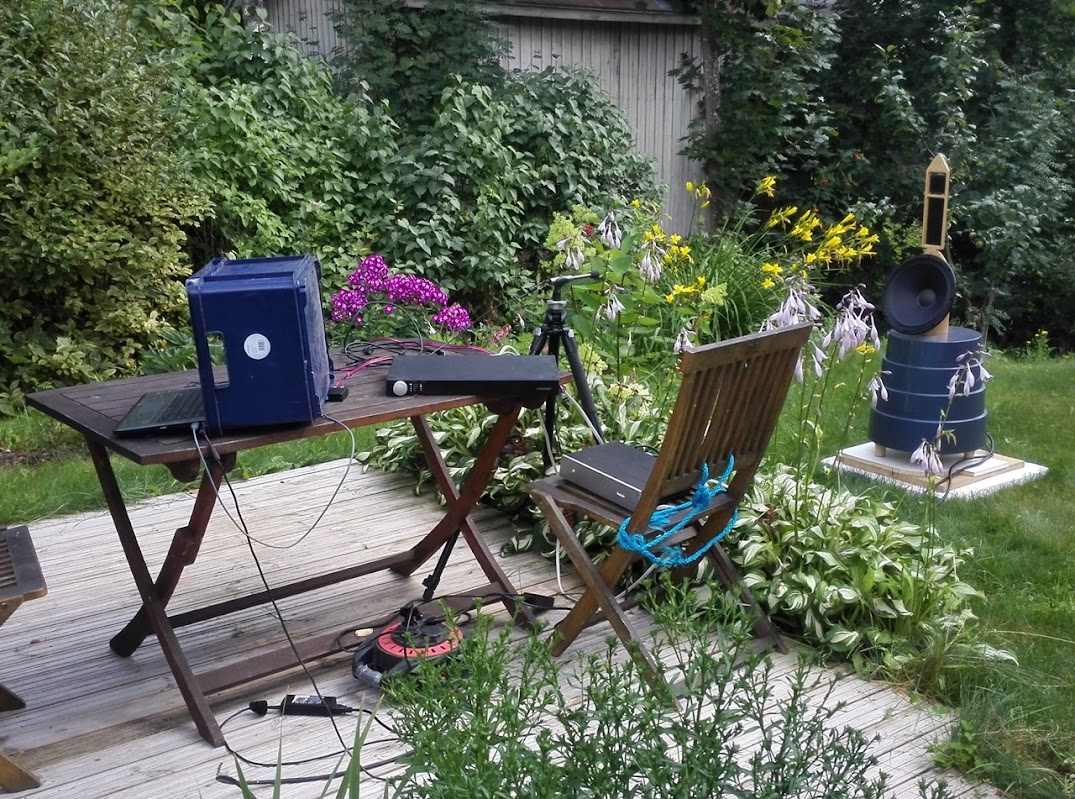
First I reran eq and xo adjustments to get best curves, slopes, match and lowest distortion, this is dsp-version vx, xos 180Hz LR2, 600Hz LR4 and 3500Hz LR4. The lowest xo range makes cardioid response because subwoofer is closed and has omnispehric radiation.
Measurements were taken on grass, 1,6m distance, mic level between upper mid and tweeter. Some wind and noise, ambient noise level 30-40dB. I used RoomEQWizard as usual and converted polar measurements for OmniMic to get polar spectrograms.
Vertical directivity is not as good because this is a tall multiway and it is also difficult to measure because itcan't be set horizontally. I enclose an indoor +/-15¤ measurement.



Attachments
Last edited:
Room response with same vx settings.
Not bad at all.Speakers 80cm from front wall, 2,5m from side walls and mic 1m from back wall. Similar setting as in earlier posts.
Those colourful piccies are wavelets, not spectrograms!


Not bad at all.Speakers 80cm from front wall, 2,5m from side walls and mic 1m from back wall. Similar setting as in earlier posts.
Those colourful piccies are wavelets, not spectrograms!


Last edited:
Those wiggles around 600 and 900Hz in outdoor measurements were ground reflections. I thought that the long grass would attenuate enough, but false!
Here new indoor frequency measurements with slightly retuned equalizations, version vX1
Here new indoor frequency measurements with slightly retuned equalizations, version vX1
An externally hosted image should be here but it was not working when we last tested it.
An externally hosted image should be here but it was not working when we last tested it.
I visited HifiEXPO 2016 in Helsinki yesterday. the highlight of the day was to finally meet Mr. Gradient Jorma Salmi! I thanked him for his work for loudspeakers and specially for Gradient 1.x series which was my inspiration and idea for AINOgradients.
The best speakers at EXPO were KEF Muon and Martion Bullfrog Active!

An externally hosted image should be here but it was not working when we last tested it.
The best speakers at EXPO were KEF Muon and Martion Bullfrog Active!
An externally hosted image should be here but it was not working when we last tested it.

- Home
- Loudspeakers
- Multi-Way
- Aino gradient - a collaborative speaker project
